Grow Impatiens ‘Busy Lizzies’ As Ideal Bedding Plants By Following These Guidelines

ANNUALS > IMPATIENS
Reviewed By DAN ORI

Dan has over 27 years’ under his belt caring for plants and gardens. Working as a Horticultural Instructor and Consultant, he draws on a diverse range of experience that includes working as a Head Gardener, Tree Surgeon, Garden Centre Trouble Shooter, and writer of academic papers. Dan has a Level 3 Diploma in Horticulture and is currently a candidate for the RHS’s most prestigious award – The Master of Horticulture.
IN THIS GUIDE
IMPATIENS GUIDES
Busy Lizzies are a shade garden standard and a byword for bedding that produces heaps of charming warm-toned blooms.
Impatiens produce masses of colourful little flowers during summer and are a brilliant bedding plant, even more so if your garden is blighted by shade, as these tender little plants will tolerate shady conditions well.
As floriferous as these popular annuals are, they also have seriously pretty foliage.
Impatiens leaves are very shapely, of an elliptic to lanceolate form, usually slightly serrated and are a rich green shade.
Overview
| Botanical Name | Impatiens |
| Common Name(s) | Impatiens, Busy Lizzie, Patience Plant, Sultana |
| Plant Type | Perennial (annual in temperate regions) |
| Native Area | East Africa |
| Hardiness Rating | H1B / H1C |
| Foliage | Evergreen |
| Flowers | Open disk-shaped flower with 5 petals, often notched and overlapping, in tones of orange, red, pink and white, 3-5cm across |
| When To Plant | April |
Sunlight
Preferred
Full Sun / Full Shade / Part Shade
Exposure
Sheltered
Size
Height
0.1 – 0.5M
Spread
0.1 – 0.5M
Bloom Time
April to August
Soil
Preferred
Sand or loam
Moisture
Moist but well-drained
pH
Any
Although Impatiens are not really annuals, they are effectively annuals in the UK and Europe and are treated as such because they cannot tolerate low temperatures.
In their native habitat of eastern Africa, they are actually evergreen perennials.1Impatiens. (n.d.). San Diego Zoo Animals & Plants. Retrieved May 18, 2023, from https://animals.sandiegozoo.org/plants/impatiens
Of a bushy, mounding habit that is naturally compact, Impatiens make terrific container plants too.
Their small sizes mean small containers, and what better way to keep these herbaceous evergreens going until the following season than by simply bringing the little pots indoors?
Gardening expert Dan Ori recommends starting again each year with standard walleriana types as it can be difficult to keep these looking healthy year on year:
“More susceptible to cold and dying out, the New Guinea Impatiens actually overwinter in the house well.”
Outdoors or indoors, these plants won’t require deadheading as they are self-cleaning.2Russ, K., & Polomski, R. (2017b, August 26). Impatiens. Home & Garden Information Center | Clemson University, South Carolina. Retrieved May 17, 2023, from https://hgic.clemson.edu/factsheet/impatiens/
Common Varieties
Over the past couple of decades, Impatiens in the UK have been struck by a widespread epidemic of downy mildew, specifically, Impatiens Downy Mildew (IDM).3Impatiens downy mildew / RHS Gardening. (n.d.). Royal Horticultural Society. Retrieved May 18, 2023, from https://www.rhs.org.uk/disease/impatiens-downy-mildew
The devastation was so great that many gardens had to cull their Impatiens and the plant began to be given up on.4Impatiens. (n.d.-b). University of Florida, Institute of Food and Agricultural Sciences. Retrieved May 18, 2023, from https://gardeningsolutions.ifas.ufl.edu/plants/ornamentals/impatiens.html
Horticulturists have since developed Impatiens hybrids and cultivar series with resistance to downy mildew.5Lonnee, D. (2021, May 19). New Downy Mildew Resistant Impatiens Cultivars. Minnesota State Horticultural Society. Retrieved May 18, 2023, from https://northerngardener.org/new-downy-mildew-resistant-impatiens-cultivars/
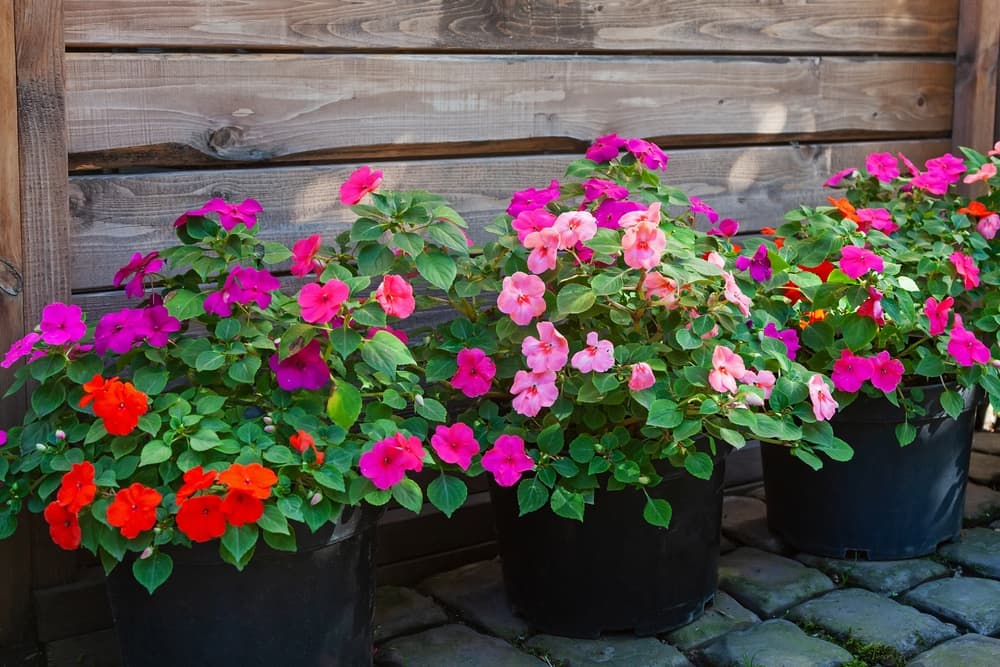
In this transitional phase, the classic varieties are available for gardeners alongside the newer series that are mildew-resistant, but I focus on the latter in this guide.
The species plant can grow anything from 15-60cm tall with the spread a shade narrower.
It bears 5-petalled flowers from 3-5cm in diameter wide which usually occur in shades of pink, purple, orange, red and white.
The following series are claimed to be downy mildew-resistant and are available in the UK.
I. Accent Series
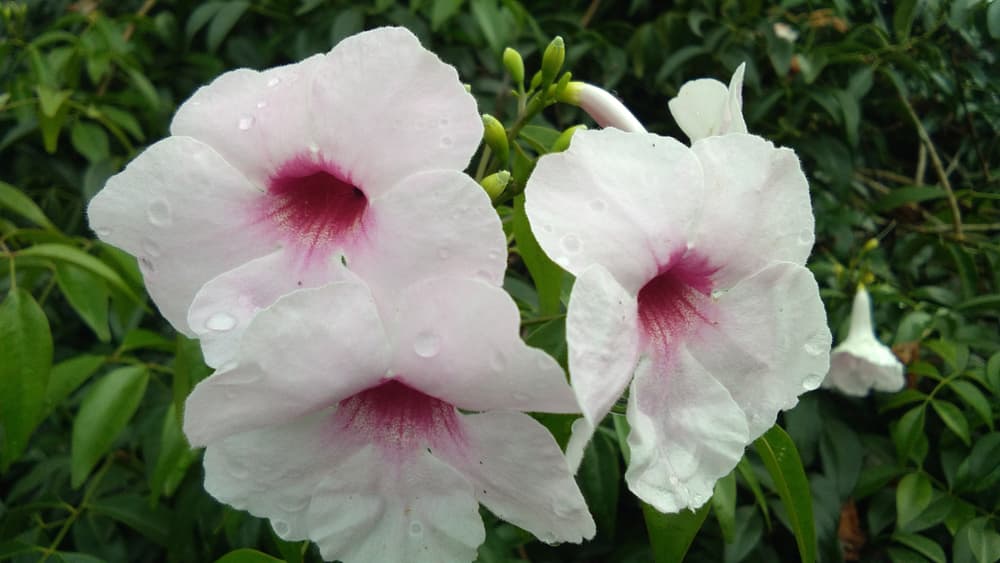
These cultivars are ultra-compact plants growing to only 20cm tall and wide.
The flowers are in standard hues, about 5cm across and have a darker eye.
Blooming starts earlier and continues for longer.
I. SunStanding Series
The SunStanding series subsumes various cultivars.
These cultivars may be grown under any exposure, in full shade to full sun.
I. SunStanding Jazzy Series
The Jazzy family features flowers that are very big at about 6cm.
Moreover, it has variegated leaves that are yellow in the centre and green at the borders.
I. walleriana Imara Series
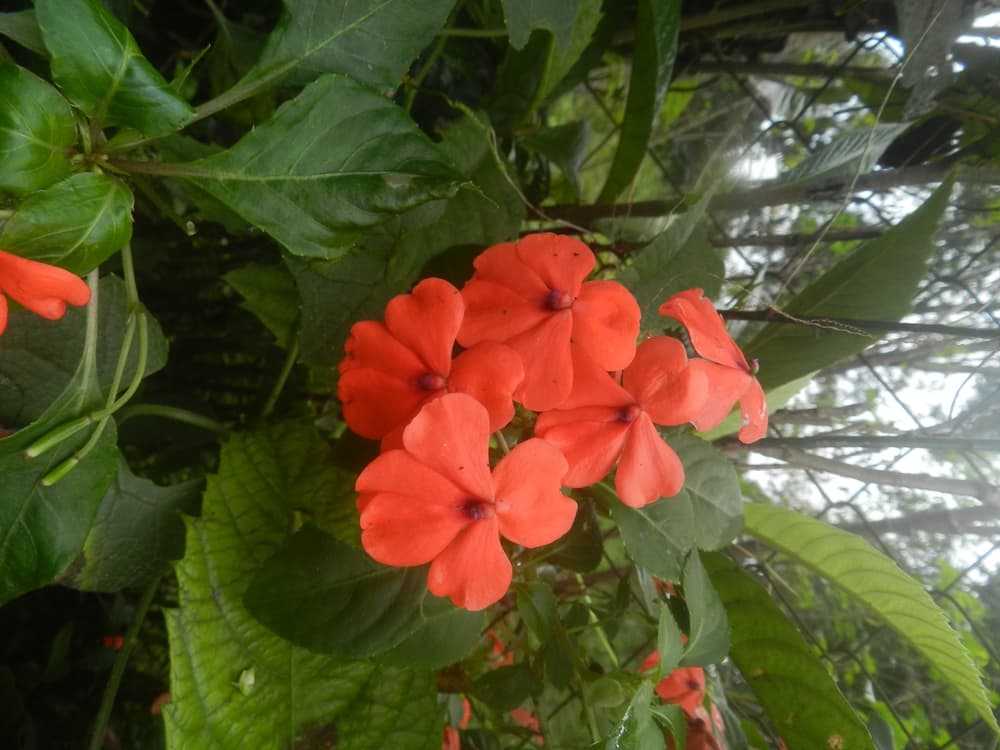
This is an award-winning series with well-branched plants from 25-30cm.
The flowers’ hues are especially brilliant and vibrant.
I. SunStanding Helios Series
These cultivars are a great buy for home gardeners.
Although the flowers are not as big as Jazzy’s, it produces them in greater profusion and even has bi-coloured blooms.
How To Grow Busy Lizzies
Busy Lizzies are easily and often grown from both seeds and cuttings.
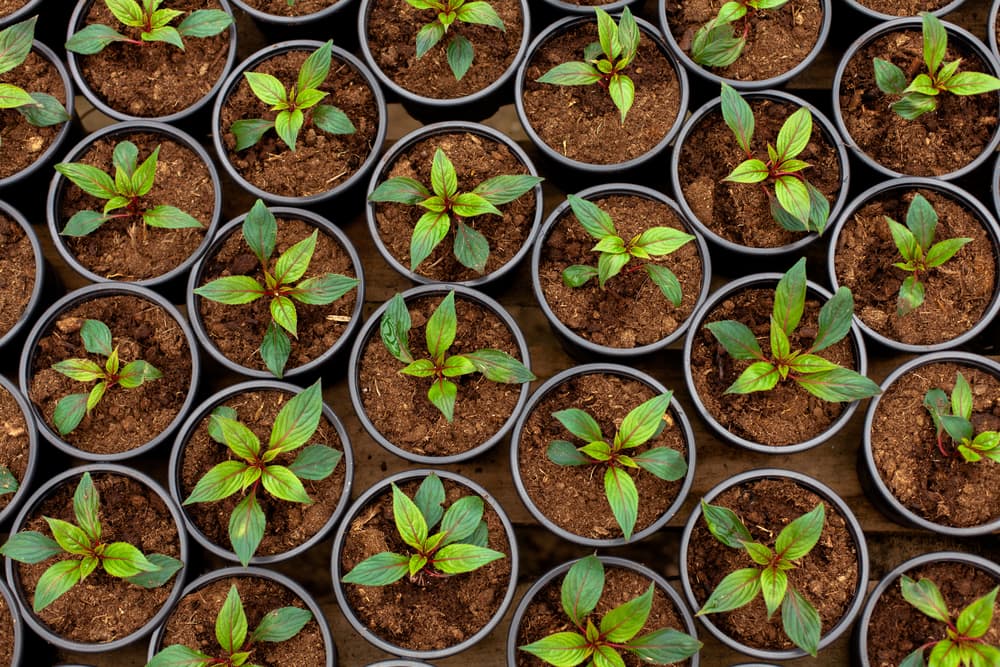
Impatiens seeds should not be sown directly outdoors in the UK as the favourable season is too short for the plants to mature and flower.
- Start seeds indoors in trays or small pots about two months before the expected last frost.
- If you sow in small pots then you will not have to pot on seedlings.
- Use a seed-starting mix for trays and potting compost amended with perlite or grit for pots.
- Sow seeds sparsely, 1-1.5cm deep.
- Dampen the medium and cover the tray or pots with clear polythene or plastic wrap to create humid conditions. The covering should have only a few small perforations.
- The temperature should range between 20-25°C; dampen daily.
- After seedlings emerge remove the covering and shift the trays or pots to a spot where they get a couple of hours of morning sunlight, or diffused or filtered sunlight later in the day; otherwise keep them under grow lights.
I find that even strong sunlight coming in through patterned glass or frosted glass becomes diffused perfectly for plant-growing purposes.
These plants are also super-easy to propagate via softwood cuttings.
Hardiness
To turn around that term ‘Fully Hardy,’ one might label Impatiens ‘Fully Tender.’
They are rated at H1B and H1C, meaning that the minimum temperatures they can tolerate are, respectively, 10°C and 5°C.
So, let alone freezing temperatures or frost, if the mercury dips to even the single digits, the temperature can kill these plants.
Though Busy Lizzies are not thought of as houseplants, the truth is that – with only a bit of effort – they make excellent potted plants for the home.
Preferred Aspect
Though different Impatiens series and cultivars have somewhat varying sun-shade preferences, all will do wonderfully well in partial shade, which is the most suitable position for them.
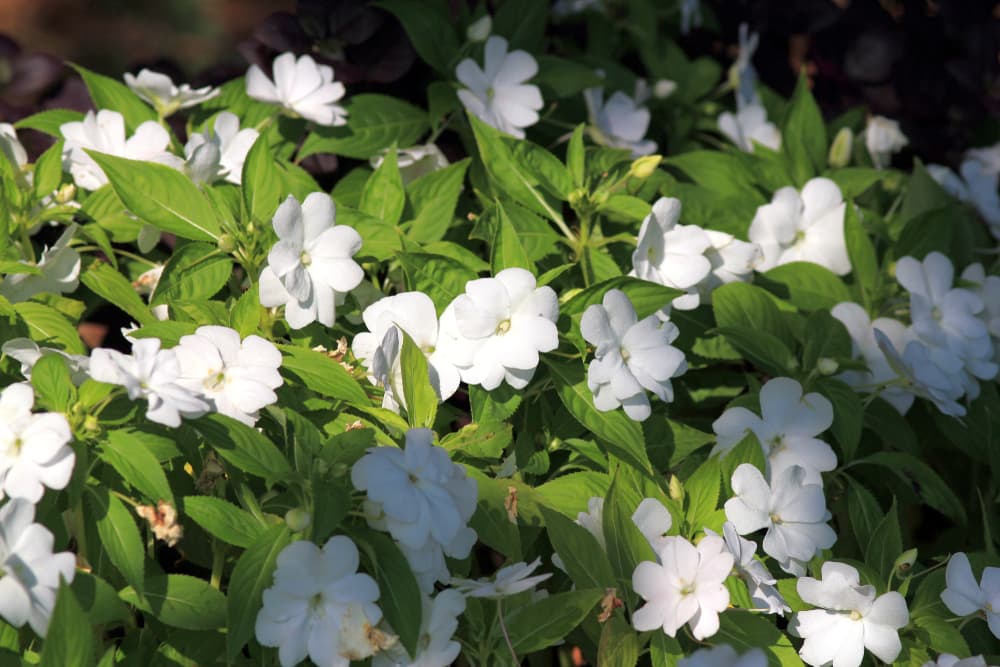
Impatiens should be sited in a sheltered spot.
Preferred Soil & Drainage
Soil should retain moisture yet drain very well. It should also be fairly rich but not dense.
So perhaps Busy Lizzies are a bit fussy about soil!
Start with a sandy loam and incorporate grit, perlite, or both to ensure excellent drainage.
Mix in organic compost in a 1:3 ratio with the loam and you’re good to go.
If you think the soil will dry out very quickly or if you are planting in full sun, then do amend with vermiculite.
Planting Impatiens
Though you may plant on Impatiens that you have grown from seed or propagated from cuttings, keep in mind that they are conveniently bought as plugs or small potted plants from nurseries and even garden centres.
Impatiens may be planted outdoors after the last frost.
It would do well to wait until the soil has warmed up to decrease the likelihood of transplant shock and to get the plants off to a good start.
In most regions of the UK this would mean sometime in April.
For soil considerations please see section Preferred Soil and Drainage.
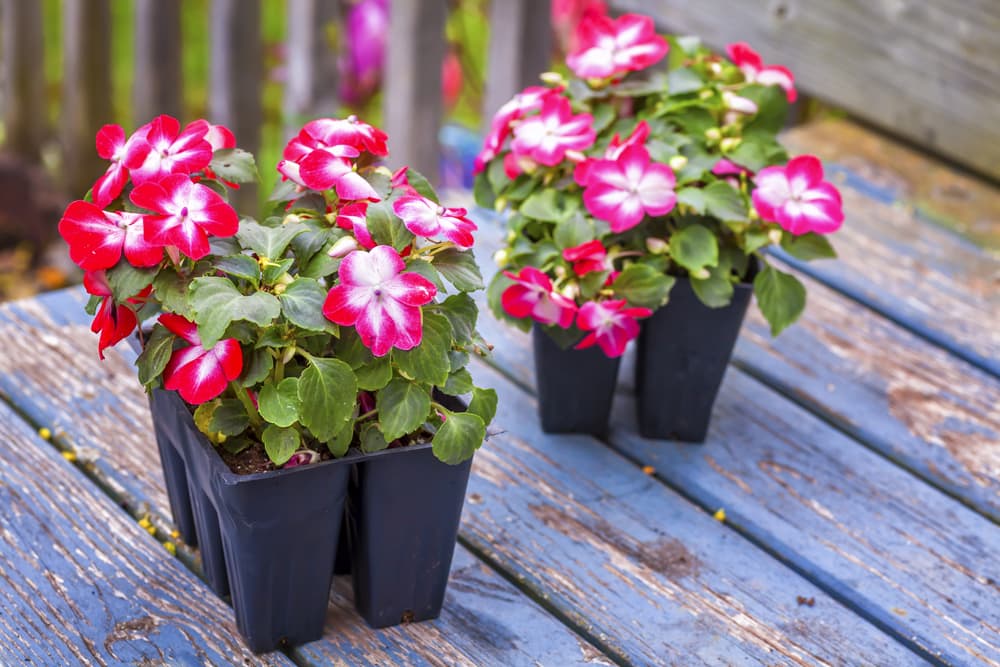
Before planting Busy Lizzies outdoors, harden them by putting the pots outdoors in the morning for four days or so for increasing periods of time.
The transplant hole should be about the same depth as the pot and twice as wide.
Space the plants by about 30cm.
Gently spread out the roots when transplanting.
When you backfill the hole ensure that the soil level is no higher on the main stem than it was in the pot. Water in the plant.
Please be aware that these plants’ roots are rather delicate so herewith a ‘Handle with Care’ advisory!
Busy Lizzies Plant Care
Impatiens need regular watering.
Do not allow the soil to stay dry, especially in hot weather.
At the same time, they also cannot stand waterlogged soil.
As they are tender evergreen perennials, open-ground plantings will die in late autumn but you can keep potted plants going year-round by bringing them indoors or moving them to the conservatory, if you have one.
For care guidelines if Impatiens are grown as houseplants, please see section Overwintering.
A big advantage that these flowering plants have is that they are self-cleaning, so there is no deadheading task.
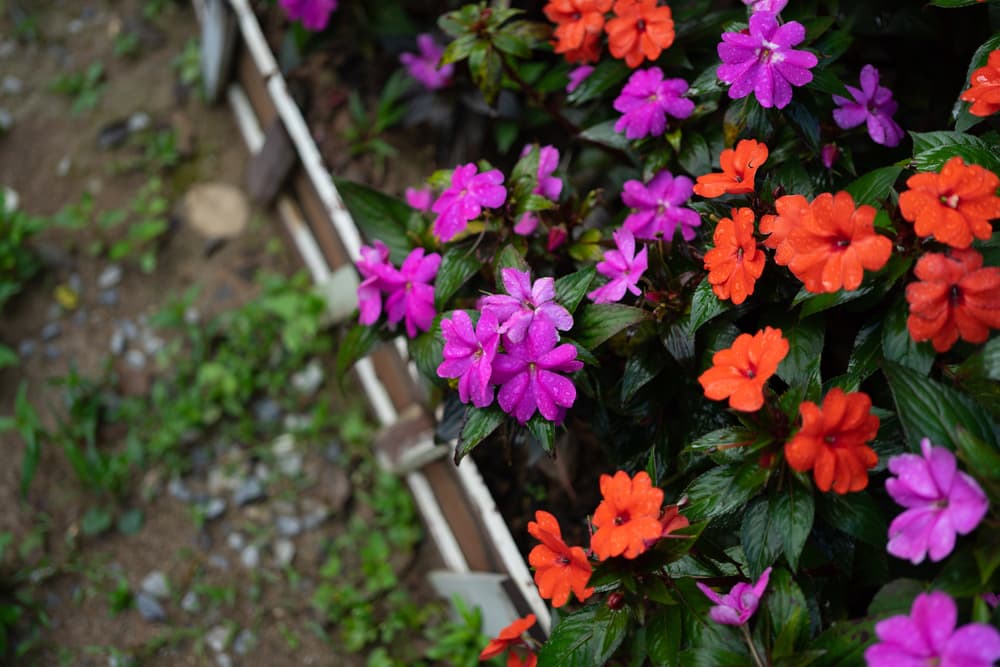
Previously I would pinch the growing tips to head off legginess and ensure compactness but newer cultivars have such a fine bushy and compact habit that even this may not be necessary.
Busy Lizzies benefit from fertilising but do not feed them with a balanced formula as it will result in excessive stem and foliage growth.
Use a phosphor- and potash-oriented formulation designed for maximising blooms.
A slow-release or controlled-release fertiliser (of the above type of formulation) for flowering plants would be perfect.
Watering
How much water Impatiens need is strongly dependent on their position and the current temperature, besides the amount of rain.
For example, if they are sited in full shade and you are experiencing cool days, then a weekly or bi-weekly watering will probably be enough, and if it has rained, then no watering at all.
But if they are positioned in full sun and you are having a heat wave and a dry spell, you will need to water them daily.
As a general rule, water open-ground Impatiens generously, allow the top centimetre or two of the soil to dry out, and then water again.
Overwintering
If you choose to overwinter your Busy Lizzies, you need to grow them in containers in the first place. Containers should have drainage holes.
Bring them indoors before the temperature falls to the single digits. ‘
Reverse-harden them first.
As far as sunlight is concerned, all they’ll need is a few hours of morning sunlight or diffused or filtered sunlight at any time of the day.
What is more important indoors are temperature and humidity.
A very suitable temperature range is between 13-22°C, and this should not pose any problem indoors.

As for humidity, typical indoor humidity is not sufficient for Impatiens plants.
Humidity needs to be between 50-70% so a humidifier will prove very useful.
To start with you could keep the pots on damp pebbles or orchid trays, mist the plants every other day, and see how it goes.
“You are more likely to cause Downy Mildew problems with misting, so watering should be enough,” advises Dan Ori.
Water in strict moderation as the plants are not growing actively and water will not dry out as much indoors as it did outdoors.
Water sufficiently to make the soil just moist and allow the soil to dry out before watering again.
Keep plants away from cold drafts and heating systems.
Companion Planting
One of the attractions of Busy Lizzies is their willingness and ability to play bridesmaid to the divas among flowering plants.
A profusion of uncomplicated Impatiens blooms in bright tones and that rich green foliage in a compact, tidy shape make for a perfect backdrop to taller flowering plants that feature complex, richly-hued blooms.
On the other hand, as Impatiens can flourish in shady areas, they become the star attractions when paired with, comparatively duller, foliage-centric evergreens and hedging.
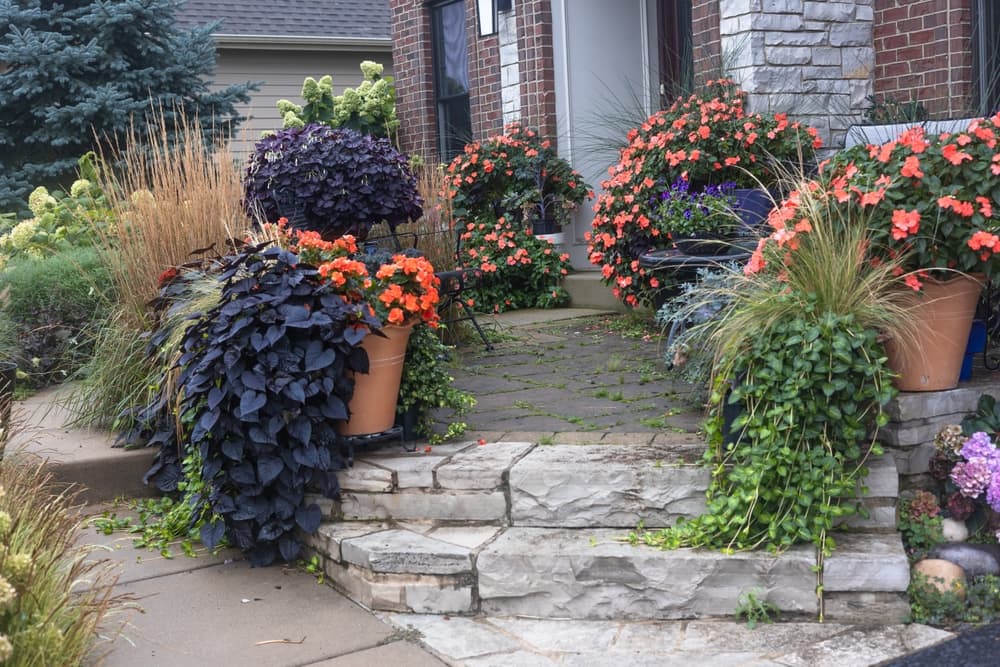
For the former type of companion planting, Aquilegia or Columbine is a great choice.
Others include Iris and Camellia. I do think that someone should pair Oriental Lily with Busy Lizzies.
For the latter type, Ferns and Hostas will be livened up with patches of Busy Lizzies.
For entirely different types of effects, try tall, elegant Delphinium among merry little Impatiens, and Hydrangea and Impatiens as ‘pari passu’ companions.
Common Problems
Impatiens flowers are not only edible, they have a pleasant sweet-vegetal taste.
And that is the main ‘common problem’ because everything from voles to deer love to snack on these plants.
There is no getting around the reality that if such herbivores are found in your locality, you will have to set up traps or, much better, deterrents and repellants.
Like many similar plants, Busy Lizzies can be attacked by aphids and wine weevils.
As mentioned, legacy varieties are very vulnerable to downy mildew.
Reviving A Dying Impatiens Plant
To try to revive a dying Impatiens plant, you need to find out why your plant might be dying.
Keep in mind that open-ground Impatiens will die in late autumn because they cannot survive winter in the UK.
If a plant is dying during the favourable season, examine the foliage, from which it will be readily apparent if the plant has been afflicted by downy mildew or attacked by herbivores.
If you observe a fine whitish down-like coating on the leaves, usually on the undersides, it is downy mildew.

If the leaves have been nibbled at and are hole-ridden, you will have to set traps, deterrents or repellants for whatever herbivores are damaging the plant.
Outdoors or indoors, Impatiens are susceptible to over and underwatering.
In both cases, the trouble will manifest initially as drooping leaves, but in most plants, the result of dry soil will be drooping leaves, while root rot will lead to leaf wilt starting from the upper and outer leaves and progressing downward and inward.
Simply check the soil to see if it is dry or soaked and think back to whether and how the plant was watered during the past 10-14 days.
While a plant dying from lack of water is easy to save if you act quickly enough, the same cannot be said for a plant affected by root rot.
References
- 1Impatiens. (n.d.). San Diego Zoo Animals & Plants. Retrieved May 18, 2023, from https://animals.sandiegozoo.org/plants/impatiens
- 2Russ, K., & Polomski, R. (2017b, August 26). Impatiens. Home & Garden Information Center | Clemson University, South Carolina. Retrieved May 17, 2023, from https://hgic.clemson.edu/factsheet/impatiens/
- 3Impatiens downy mildew / RHS Gardening. (n.d.). Royal Horticultural Society. Retrieved May 18, 2023, from https://www.rhs.org.uk/disease/impatiens-downy-mildew
- 4Impatiens. (n.d.-b). University of Florida, Institute of Food and Agricultural Sciences. Retrieved May 18, 2023, from https://gardeningsolutions.ifas.ufl.edu/plants/ornamentals/impatiens.html
- 5Lonnee, D. (2021, May 19). New Downy Mildew Resistant Impatiens Cultivars. Minnesota State Horticultural Society. Retrieved May 18, 2023, from https://northerngardener.org/new-downy-mildew-resistant-impatiens-cultivars/

